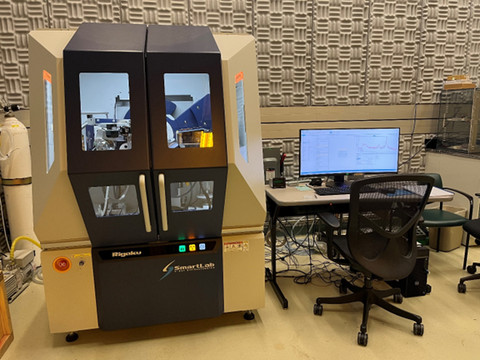NanoFab Tool: Rigaku SmartLab X-Ray Diffraction

The Rigaku SmartLab X-ray diffraction system (XRD) is a fully automated, modular system for advanced x-ray diffraction measurements on a wide range of materials including thin films and powders. The system uses a high power, 9 kW rotating anode X ray generator which allows faster collection times with less background noise and is optimized for advanced thin film measurements. This XRD system can be used to determine the crystal structure and identify the phases of thin films and bulk materials. The SmartLab is easy to use and is fully equipped with modules for performing a variety of advanced X ray diffraction measurements such as X ray reflectivity, grazing incidence diffraction, reciprocal space maps, rocking curves, and small angle X ray scattering (SAXS). The SmartLab Guidance software guides the user through alignments and experimental setups, making the system very easy to use.
Specifications/Capabilities
- 9 kW rotating anode x-ray generator.
- X-ray generator ranges: 20 kV to 45 kV; 10 mA to 200 mA.
- HyPix 3000 two-dimensional semiconductor detector with an active area of 3000mm2 and pixel of 100 um2. It is single photon counting x-ray detector with a count greater than 106cps/pixel.
- Five axis high resolution goniometer with an Eulerian cradle, X-Y-Z sample stage.
- Parallel beam optics with a multi-layer X-ray mirror.
- Bragg Brentano focusing optics.
- Computer controlled variable divergence slit and variable anti-scatter slit
- Germanium (220) 2-bounce and 4-bounce, and (400) 2-bounce channel cut monochromators, and a germanium (220) 2-bounce analyzer.
- Anton Paar domed hot stage for high temperature measurements of up to 1100° C in air, vacuum, or inert gas.
Usage Information
Supported Sample Sizes
- Maximum wafer diameter: 200 mm.
- Small pieces supported: Yes.
- Powder Samples: Yes
Typical Applications
- Bragg Brentano powder diffraction: Determine the composition of powders and polycrystalline thin films.
- High resolution XRD (HRXRD): Determine the structure of epitaxial thin films including film composition, thickness, orientation, and superlattice period. Characterize the defects in epitaxial thin films such as mismatch, lattice strain relaxation, misorientation, dislocation density, surface damage, and curvature.
- X-ray reflectivity (XRR): Determine the properties of the topmost layer such as thin film layer thickness, surface and interface roughness, density or composition.
- Rocking curves: Determine the composition and defects in epitaxial or nearly epitaxial films.
- Grazing incidence XRD (GIXRD): Determine the lattice strain in highly textured polycrystalline films and the composition, defects, and crystallite size of polycrystalline thin films.
- In plane grazing incidence XRD: Determine the composition, defects, orientation, and residual stress in textured polycrystalline thin films.
- Small Angle X-ray Scattering (SAXS): Determine the size and size distribution of nanomaterials.

